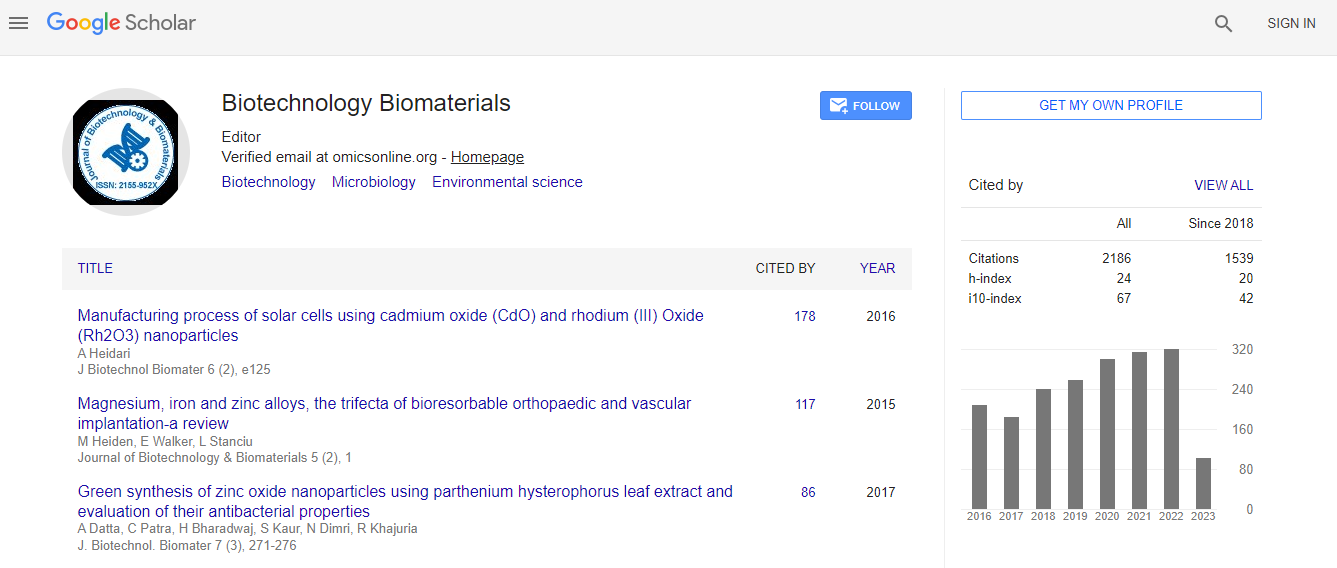Our Group organises 3000+ Global Conferenceseries Events every year across USA, Europe & Asia with support from 1000 more scientific Societies and Publishes 700+ Open Access Journals which contains over 50000 eminent personalities, reputed scientists as editorial board members.
Open Access Journals gaining more Readers and Citations
700 Journals and 15,000,000 Readers Each Journal is getting 25,000+ Readers
Google Scholar citation report
Citations : 3330
Journal of Biotechnology & Biomaterials received 3330 citations as per Google Scholar report
Indexed In
- Index Copernicus
- Google Scholar
- Sherpa Romeo
- Open J Gate
- Genamics JournalSeek
- Academic Keys
- ResearchBible
- China National Knowledge Infrastructure (CNKI)
- Access to Global Online Research in Agriculture (AGORA)
- Electronic Journals Library
- RefSeek
- Hamdard University
- EBSCO A-Z
- OCLC- WorldCat
- SWB online catalog
- Virtual Library of Biology (vifabio)
- Publons
- Geneva Foundation for Medical Education and Research
- Euro Pub
- ICMJE
Useful Links
Recommended Journals
Related Subjects
Share This Page
Utilization of agro/industrial wastes for high-level expression of recombinant endo-mannanase by Escherichia coli and its application in oil extraction from Copra
6th World Congress on Biotechnology
Gaurav Singh Kaira, Deepesh Panwar and Mukesh Kapoor
CSIR-Central Food Technological Research Institute, India
Posters-Accepted Abstracts: J Biotechnol Biomater
Abstract
The high enzyme titers of recombinant endo-mannanases (EC 3.2.1.78) have really boosted their industrial prospects in food, feed, oil drilling, textiles and pulp sectors but the high cost associated with their production is still acting as a major deterrent. In the present work, three pronged-approach was employed to ameliorate and economize ManB-1601 (recombinant endo-mannanase, accession no: KM404299) production. Firstly, pRSETA manb-1601 construct was transformed in HIControl E.coli BL21 (DE3) cells which resulted in 2.7 fold (1821 IU/ml, 42.5 hours post-induction) increase in ManB-1601 production as compared to the previous host. The second approach focused on understanding the interplay between various nutritional and physical factors. Shifting of induction time to 5 hours resulted in up to 1.89 fold improvement in enzyme yield (2268 IU/ml) and volumetric enzyme productivity (81 IU/ml/h). Replacement of IPTG with lactose improved ManB-1601 production by 1.77 fold (4031 IU/ml). Efforts to improve the cell membrane permeability using chemical (glycine, calcium chloride) and physical [incubation temperature higher (42o C) or lower (16-25o C)] methods were found counter-productive. Increment in protein (by peptone) and carbohydrate (by glycerol) concentration to 2.0 % (w/v) and 0.25% (v/v) resulted in up to 2.08 fold (8406 IU/ml) increase in ManB-1601 titers. However, doubling (2X) or quadrupling (4X) the concentration of optimized medium proved detrimental. Under the third approach, up to 70.45% (w/v) of protein in the optimized media was successfully replaced with soluble protein from defatted flax seed meal in presence of glycerol (0.25% v/v) and lactose (1.5 mM) and resulted in 5926 IU/ml of ManB-1601. Treatment of grated copra with purified ManB-1601 (220 IU/g) resulted in 9.1% higher oil yield when compared to control. Laser scanning confocal microscopy and scanning electron micrographs studies depicted significant reduction in oil-droplet size and subtle changes in the copra morphology, respectively in enzyme treated samples. No change in FAME profiles was observed after ManB-1601 treatment.Biography
Email: mkapoor@cftri.res.in

 Spanish
Spanish  Chinese
Chinese  Russian
Russian  German
German  French
French  Japanese
Japanese  Portuguese
Portuguese  Hindi
Hindi 
